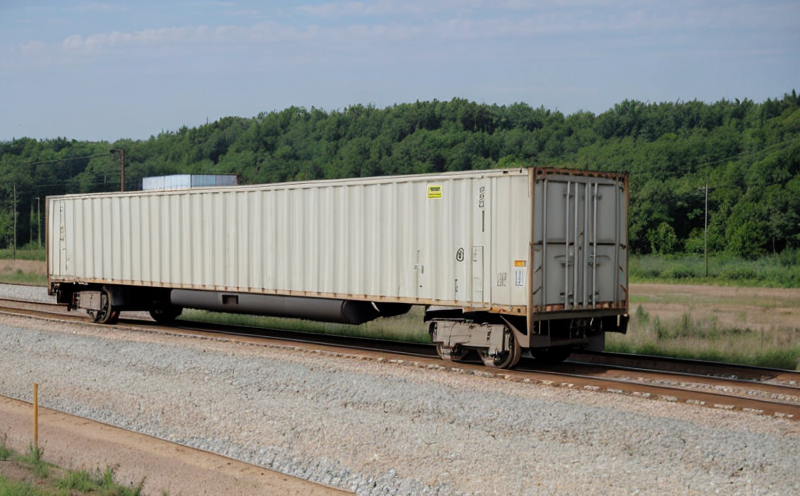Cargo & Freight Wagon Testing
Within the railway and transportation sector, cargo and freight wagon testing is a critical aspect of ensuring operational safety, efficiency, and compliance with international standards. As transportation networks expand and evolve, the demand for robust wagons that can withstand harsh conditions has never been greater. This service plays an essential role in evaluating the structural integrity, material durability, and operational performance of railway wagons.
The testing process begins with a comprehensive assessment of the wagon’s design and specifications, ensuring compliance with relevant international standards such as ISO 18049 for wagons and EN 627-5:2013 for rail vehicles. These standards provide guidelines on how to conduct tests that ensure safety and reliability under various operating conditions.
The testing framework encompasses a range of physical and functional evaluations, including structural integrity checks, fatigue resistance assessments, and durability studies. Structural integrity is verified through non-destructive testing methods like ultrasonic testing (UT) and magnetic particle inspection (MPI), which help detect flaws in the materials without causing damage. Fatigue resistance is assessed by simulating real-world conditions to determine how many cycles a wagon can withstand before failure.
Material durability tests involve exposing the components of the wagon, such as axles, couplers, and brake systems, to simulated environmental factors like temperature changes, humidity, and vibration. This ensures that all parts function correctly under expected operational stresses. The testing also includes functional evaluations, where the entire wagon undergoes dynamic performance checks on test tracks.
Once tests are completed, detailed reports are generated summarizing findings and recommendations for any necessary modifications or improvements. These reports serve as vital documentation for stakeholders involved in railway operations, ensuring that only high-quality wagons enter service.
The importance of this testing cannot be overstated. It directly impacts the safety and reliability of freight transportation systems worldwide. By adhering to stringent quality control measures during production and regular maintenance, railways can minimize accidents, reduce downtime, and enhance overall efficiency. This not only benefits the railway operators but also contributes significantly to public safety by preventing potential derailments or other catastrophic incidents.
Moreover, compliance with international standards helps ensure that wagons meet regulatory requirements set forth by governing bodies like the UIC (Union Internationale des Chemins de Fer) and national authorities. This ensures seamless integration into existing railway networks and facilitates smooth cross-border operations.
In summary, cargo and freight wagon testing is a cornerstone of modern railway infrastructure management. It guarantees that each wagon meets rigorous performance expectations while maintaining optimal safety standards. Through thorough examination processes and meticulous reporting, this service contributes significantly to the reliability and longevity of transportation systems globally.
Benefits
- Enhanced Safety: Ensures that all components can withstand real-world stresses, reducing the risk of accidents and injuries.
- Improved Reliability: Detects potential issues early on, preventing costly repairs later in the operational lifecycle.
- Compliance Assurance: Meets international standards, ensuring seamless integration into existing railway networks.
- Prolonged Lifespan: By identifying weaknesses and addressing them promptly, this service helps extend the useful life of wagons.
- Economic Efficiency: Minimizes downtime due to failures, optimizing resource allocation and operational costs.
Quality and Reliability Assurance
The pursuit of quality and reliability in cargo and freight wagon testing is paramount for maintaining the highest standards within the railway sector. Quality assurance (QA) involves a systematic approach to ensuring that all processes, from design through manufacturing and maintenance, meet established criteria for excellence.
Reliability assurance focuses on demonstrating that wagons perform consistently over time under various conditions. This includes conducting rigorous tests in controlled environments as well as real-world scenarios to simulate operational stress levels accurately. The aim is not only to identify potential weaknesses but also to provide actionable insights into improving design and manufacturing processes further.
Both QA and RA are integral parts of the broader quality management system (QMS), which provides a framework for continuous improvement across all aspects of wagon development and maintenance. By adhering strictly to QMS protocols, laboratories can ensure that their tests remain consistent and accurate over time.
Achieving top-tier quality and reliability in cargo and freight wagon testing requires meticulous attention to detail at every stage of the process—from initial design reviews to final inspection before shipment or deployment. This includes utilizing advanced technologies such as finite element analysis (FEA) for predicting structural behavior under load conditions, computer-aided design (CAD) software for creating precise blueprints, automated testing equipment capable of replicating field conditions, and sophisticated data analytics tools that help interpret results effectively.
By implementing robust QA and RA practices, laboratories can build trust with clients by delivering consistent, high-quality test outcomes. This builds long-term relationships based on mutual respect and shared goals towards safer, more efficient transportation systems.





